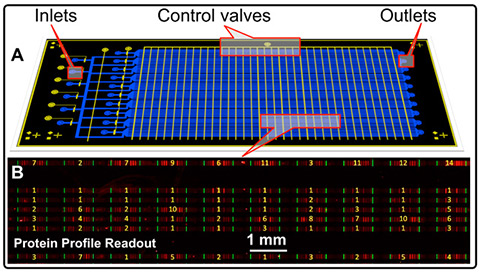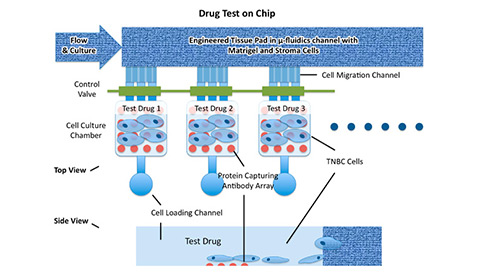Microfluidics for Disease Diagnostics
Approach 1: Microfluidics research under Lidong Qin, PhD, focuses on developing integrated proteomic microchips to analyze cell heterogeneity using state-of-the-art bioinformatics tools and identifying metastatic signatures. The research aims are to deliver brand-new technologies and methodologies capable of identifying tumor-initiating cells, discovering potential biomarkers for clinical diagnosis and targeted therapy, and identifying cancer patients with metastatic propensity.

Typical Microfluidics Device. (A) An autocad drawing to show our design of single cell barcode chip (SCBC). This schematic picture presents 100 horizontal channels x 36 vertical valves and creates 3600 microchambers for the single-cell experiment. Chamber number could expand to 300 x 50 = 15,000 for a PDMS device bonding to a 75 mm x 50 mm glass substrate. (B) A typical scanned protein barcode image zoomed from a portion of the SCBC device. The protein expression level from single cell or a few cell chambers is measured by fluorescent intensity shown as red bars in between green bar pairs. Yellow numbers represent cell number counted from the experiment, resulting in the barcode image.
Problem 2: Inspired by a global need for better diagnosis and treatment strategies, this research focuses on point-of-care (POC) challenges to ultimately design a flexible multiplatform microfluidic device for the rapid and direct characterization of rare, disease-related cells for individualized patient care.
Approach 2: We intend to revolutionize disease diagnosis and treatment strategies globally through the following measures:
- Fabricating selective and sensitive microfluidic devices that can detect antigens secreted by rare, disease-related cells on a single cell level at concentrations below the sub-picomolar level
- Correlating amounts of secreted antigens with aggression/metastatic behaviors of the disease by on-chip quantitative analysis using fluorescence for more personalized care
- Facilitating 10 or more different drug treatments simultaneously on a single microfluidic chip in 24 hours
- Scaling up production, delivering devices worldwide and commencing preclinical studies at the community level in resource-poor settings through overseas collaborations for fast delivery of cutting edge technology to those who need it most

